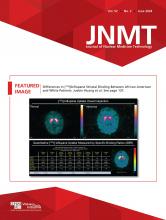Abstract
Malignancy in struma ovarii is rare and observed in only 5%–10% of patients. Here, we present a patient with malignant struma ovarii and coexisting intrathyroidal papillary thyroid carcinoma, with recurrence (large pouch-of-Douglas mass) and metastases (bilateral pulmonary and iliac nodal metastases) presenting 12 y after surgery. The notable features in this case were a concurrent intrathyroidal follicular variant of papillary carcinoma; the highly functioning nature of the malignant lesions, characterized by a low level of thyroid-stimulating hormone even without thyroxine suppression; and the low-grade 18F-FDG avidity of these lesions, consistent with their well-differentiated nature. With the adoption of a multimodality approach (surgery, radioiodine scintigraphic evaluation, and multiple radioiodine therapies), the patient showed a progressive decrease in the functionality of the disease, prolonged progression-free survival, and a good quality of life with symptom-free status at 5 y.
- malignant struma ovarii
- follicular variant of papillary thyroid carcinoma
- quality of life
- radioiodine therapy
- 131I
Footnotes
Published online Jul. 11, 2023.
This article requires a subscription to view the full text. If you have a subscription you may use the login form below to view the article. Access to this article can also be purchased.
SNMMI members
Login to the site using your SNMMI member credentials
Individuals
Login as an individual user







